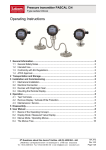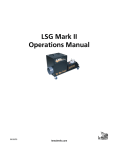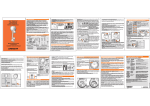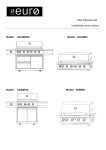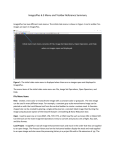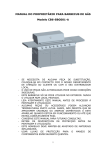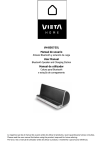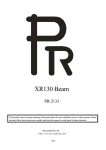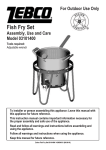Download Cadero CB6-SBG001-A User manual
Transcript
USER MANUAL FOR GAS BARBECUE GRILL CB6-SBG001-A • FOR PROPANE ONLY. • IF A REPLACEMENT IS NECESSARY, PLEASE CONTACT EITHER OUR CUSTOMER SERVICE DEPARTMENT OR YOUR LOCAL DEALER. • THE USE OF UNAUTHORISED PARTS CAN CREATE UNSAFE CONDITIONS AND ENVIRONMENT. • FOR OUTDOOR USE ONLY. • READ THE MANUAL CAREFULLY BEFORE ASSEMBLY AND USE. • ACCESSIBLE PARTS MAY BE VERY HOT. PLEASE KEEP YOUNG CHILDREN AND PETS AWAY. • PLEASE RETAIN THESE INSTRUCTIONS FOR FUTURE REFERENCE. • PLEASE REMOVE ANY PACKAGING BEFORE ASSEMBLY AND USE. • PLEASE READ THE CARE AND WARRANTY INSTRUCTIONS CAREFULLY BEFORE USE. Safety Symbols The symbols and boxes shown below explain what each heading means. Read and follow all of the ! WARNING ! messages found throughout the manual. ! WARNING ! ! CAUTION ! ! DANGER ! Indicates an imminently hazardous situation which, if not avoided, will result in death or serious injury. ! CAUTION ! ! DANGER ! WARNING ! Be alert to the possibility of serious bodily injury if ! CAUTION ! the instructions are not followed. Be sure to read ! DANGER ! and carefully follow all of the messages. ! If you smell gas: 1. 2. 3. 4. ! WARNING ! ! CAUTION ! Indicates a potentially hazardous situation. If not ! DANGER ! avoided, may result in minor or moderate injury. Shut off gas to the appliance. Extinguish any open flame. Open the lid If odor continues, keep away from the appliance and immediately call your gas supplier or your fire department. ! WARNING ! 1. Do not store or use gasoline or other flammable liquids or vapors in vicinity of this or any other appliance. 2. An LP cylinder that is not connected for use should not be stored in the vicinity of this or any other appliance. ! CAUTION ! ! DANGER ! ! WARNING ! Combustion by-products produced when using this product contain chemicals known to the State of California to cause cancer, birth defects, and other reproductive harm. ! CAUTION ! ! WARNING DANGER ! ! CAUTION ! For residential use only. Do not use for commercial cooking. ! DANGER 2 ! EIGHT BURNERS GAS BARBECUE GRILL PARTS LIST DESCRIPTION QUANTITY Cooking Grate . . . . . . . . . . . . . . . . . . . . . . . . . . . . . . . . . . . . . . . . . . . . . . . . . . . . . . . . . .3 Flame Tamer . . . . . . . . . . . . . . . . . . . . . . . . . . . . . . . . . . . . . . . . . . . . . . . . . . . . . . . . . .6 Swing-away Warming Rack . . . . . . . . . . . . . . . . . . . . . . . . . . . . . . . . . . . . . . . . . . . . . . . .1 Firebox Assembly . . . . . . . . . . . . . . . . . . . . . . . . . . . . . . . . . . . . . . . . . . . . . . . . . . . . . . .1 Side Shelf Assembly . . . . . . . . . . . . . . . . . . . . . . . . . . . . . . . . . . . . . . . . . . . . . . . . . . . . .2 Cabinet Top Plate . . . . . . . . . . . . . . . . . . . . . . . . . . . . . . . . . . . . . . . . . . . . . . . . . . . . . . .1 Cabinet Side Plate-Left Assembly . . . . . . . . . . . . . . . . . . . . . . . . . . . . . . . . . . . . . . . . . .1 Cabinet Side Plate-Right Assembly . . . . . . . . . . . . . . . . . . . . . . . . . . . . . . . . . . . . . . . . . .1 Cabinet Inside Plate - Left . . . . . . . . . . . . . . . . . . . . . . . . . . . . . . . . . . . . . . . . . . . . . . . . .1 Cabinet Inside Plate - Right . . . . . . . . . . . . . . . . . . . . . . . . . . . . . . . . . . . . . . . . . . . . . . . . 1 Cabinet Rear Plate. . . . . . . . . . . . . . . . . . . . . . . . . . . . . . . . . . . . . . . . . . . . . . . . . . . . . . . 1 Cabinet Door Plate - Left Assembly . . . . . . . . . . . . . . . . . . . . . . . . . . . . . . . . . . . . . . . . .1 Cabinet Door Plate - Right Assembly . . . . . . . . . . . . . . . . . . . . . . . . . . . . . . . . . . . . . . . . .1 Drawer Assembly . . . . . . . . . . . . . . . . . . . . . . . . . . . . . . . . . . . . . . . . . . . . . . . . . . . . . . . .2 Base Plate Assembly . . . . . . . . . . . . . . . . . . . . . . . . . . . . . . . . . . . . . . . . . . . . . . . . . . . . . 1 Gas Tank Supporter Assembly . . . . . . . . . . . . . . . . . . . . . . . . . . . . . . . . . . . . . . . . . . . . . .1 3 ASSEMBLY STEPS ! CAUTION ! Sharp edges! Wear gloves if necessary 1 Tighten the screws M6X15 4PCS 2 4 3 Flame Tamer 4 Instruction for replacing burners (if burners need to be replaced) (1) (2) 5 (3) 5 Place cooking grates (No. 2) into main body. Grate wires running front to back should be toward the top side of square tubes at each end. No. 2 6 6 7 AA Battery (Battery is not provided) 7 ! CAUTION ! ! DANGER ! 1. Never fill the cylinder beyond 80% full. An overfilled cylinder (liquid propane LP) tank is hazardous due to possible propane being released from the safety relief valve. 2. Do not store a spare LP cylinder under or near this barbeque grill or in an enclosed area. GENERAL INSTALLATION LP Tank Removal, Transport and Storage TURN OFF all control knobs and LP tank valve. Turn coupling nut counter-clockwise by hand only. DO NOT use tools to disconnect. Loosen tank screw beneath bottom shelf, then lift LP tank up and out of cart. Install safety cap onto LP tank valve. Always use cap and strap supplied with valve. Failure to use safety cap as directed may result in serious personal injury and/or property damage. 3. If the information in Steps 1 and 2 are not followed exactly, a fire causing death or serious injury may occur. 4. The safety relief valve on the LP tank could activate, releasing propane and cause an intense fire with risk of property damage, serious injury or death. 5. If you see, smell or hear escaping gas, immediately get away from the LP tank and call your fire department. 6. All spare LP tanks must have safety caps installed on the tank outlet. A disconnected LP tank in storage or being transported must have a safety cap installed (as shown). DO NOT store an LP tank in enclosed spaces such as carport, garage, porch, covered patio or other building. NEVER leave an LP tank inside a vehicle which may become overheated by the sun. DO NOT store an LP tank in an area where children play. The LP tank used with your grill must meet the following requirements: Use LP tanks only with these required measurements: 12” (30.5cm) diameter x 18” (45.7cm) tall with 20 lb 9 kg.) capacity maximum. LP tank valve must have: (1) Type 1 outlet compatible with regulator or grill (2) Safety relief valve The LP tank must be constructed and marked in accordance with the specifications required for LP cylinders. Place dust cap on cylinder valve outlet whenever the cylinder is not in use. Only install the type of dust cap on the cylinder valve outlet that is provided with the cylinder valve. Other types of caps or plugs may result in leakage of propane. 8 The LP tank must be provided with a listed overfilling prevention device. LP tank must be arranged with vapor withdrawal and include a collar to protect LP tank valve. LP (Liquified Petroleum Gas) LP gas is odorless and colorless when produced. For your safety, LP gas has been given an odor so that it can be smelled. LP gas is highly flammable and may ignite unexpectedly when mixed with air. LP Tank Filling Use only licensed or experienced dealer. LP dealer must purge new tank before filling. Dealer should NEVER fill LP tank more than 80% of LP tank volume. Volume of propane in tank will vary by temperature. A frosty regulator indicates gas overfill. Immediately close LP tank valve and call local LP gas dealer for assistance. DO NOT release liquid propane (LP) into the atmosphere. This is a hazardous practice. Always keep LP tanks in an upright position during use, transit or storage. Leak test LP tanks BEFORE connecting to grill. LP TANK LEAK TEST For your safety: Leak test must be repeated each time when LP tank is exchanged or refilled. DO NOT SMOKE during leak test. DO NOT use an open flame to check for gas leaks. 9 The grill must be tested outdoors in a well-ventilated area, away from ignition sources such as gas fired or electrical appliances. During leak test, keep grill away from open flames or sparks. Use a clean paintbrush and a 50/50 mild soap and water solution. Brush soapy solution onto areas indicated by arrows in figure below. ! WARNING ! ! CAUTION ! DO NOT use chemical household cleaning agents. Damage to gas train components can result. ! DANGER ! ! WARNING ! If growing bubbles appear, DO NOT use or move the LP tank. Contact an LP gas supplier or your fire department. ! CAUTION ! ! DANGER ! Connecting Regulator to the LP Tank 1. LP tank must be properly secured onto grill. 2. Turn all control knobs, including side burner to the OFF position. 3. Turn LP tank OFF by turning hand-wheel clockwise to a stop. 4. Remove the protective cap from LP tank valve. Always use cap and strap supplied with valve. 10 5. Hold regulator and insert nipple into LP tank valve. Hand-tighten the coupling nut, holding regulator in a straight line wtih the LP tank valve so as not to cross-thread the connection. Nipple has to be centered in the LP tank valve. Hold coupling nut and regulator as shown for proper connection to LP tank valve. 6. Turn the coupling nut clockwise and tighten to a full stop. The regulator will seal on the back-check feature in the LP tank valve, resulting in some resistance. An additional one-half to three-quarter turn is required to complete the connection. Tighten by hand only. Do not use tools. 7. The cylinder should be kept vertical with ground. If the cylinder is tilted, it is dangerous and may cause gas to leak. WRONG CORRECT NOTE: If you CANNOT complete the connection, disconnect regulator and repeat Steps 5 and 6. If you are still unable to complete the connection, DO NOT use this regulator. ! WARNING ! DO NOT insert any foreign objects into the valve outlet. You may damage the valve and cause a leak. Leaking propane may result in an explosion, fire and cause severe personal injury or death. ! CAUTION ! NEVER attempt to attach this grill to the self-contained LP gas system of a camper trailer or motor home. ! DANGER ! DO NOT use grill until leak-tested. If a leak is detected at any time, STOP and CALL the fire department. If you cannot stop a gas leak, immediately CLOSE LP tank valve and call LP gas supplier or your fire department. 11 LEAK TESTING VALUES, HOSE AND REGULATOR 1. Turn all grill control knobs to OFF 2. Be sure regulator is tightly connected to LP tank. 3. Completely open LP tank valve by turning hand wheel counter-clockwise. If you hear a sound, turn gas off immediately. It could mean there is a major leak. Correct before proceeding. 4. Brush soapy solution onto areas circled above. 5. If “rowing” bubbles appear, there is a leak. Close LP tank valve immediately and retighten connections. IF LEAKS CANNOT BE STOPPED, DO NOT TRY TO REPAIR. Call for replacement parts or order new parts. 6. Always close LP tank valve after performing leak test by turning head wheel closkwise. 7. The pressure regulator and hose assembly supplied with this appliance must be used. Replacement pressure regulator and hose assemblies must be specified by the appliance manufacture. ! WARNING ! For safe use of your grill and to avoid serious injury: ! CAUTION ! DO NOT let children operate or play near grill. ! DANGER DO NOT block holes in bottom or back of grill. ! Check burner flames regularly. Use grill in well-ventilated space. NEVER use in enclosed spaces such as carport, garage, porch, covered patio, or under an overhead structure of any kind. DO NOT use charcoal or ceramic briquets in a gas grill (unless briquets are supplied with your grill.) 12 Use grill at least 3 ft. from any wall or surface. Maintain 10 ft. clearance to objects that can catch fire or sources of ignition such as pilot lights on water heaters, live electrical appliances, etc. APARTMENT DWELLERS: Check with management to learn the requirements and fire codes for using an LP gas grill in your apartment complex. If allowed, use outside on the ground floor with a three-foot clearance from walls. DO NOT use on or under balconies. NEVER attempt to light burner with lid closed. A buildup of non-ignited gas inside a closed grill is hazardous. NEVER operate grill with LP tank out of correct position specified in assembly instructions. Always close LP tank valve and remove coupling nut before moving LP tank from specified operation position. SAFETY TIPS Before opening LP tank valve, check the coupling nut for tightness. When grill is not in use, turn off all control knobs and LP tank valve and close lid. NEVER move grill while in operation or while still hot. Use long-handled barbeque utensils and oven mitts to avoid burns and splatters. Maximum load for side burner and side shelf is 10 pounds. The grease tray must be attached to grease clip and emptied after after each use. DO NOT remove grease cup until grill has completely cooled. If you notice grease or other hot material dripping from grill onto valve, hose or regulator, turn off propane gas supply at once. Determine the cause, correct it, then clean and inspect valve, hose and regulator before continuing. Perform a leak test. Keep ventilation openings in cylinder enclosure (grill cart) free and clear of debris. The regulator may make a humming or whistling noise during operation. This will not affect safety or use of grill. If you have a grill problem, see the “Troubleshooting Section” 13 ! WARNING ! ! CAUTION ! Putting out grease fires by closing the lid is not possible. Grills are well ventilated for safety reasons. ! DANGER ! DO NOT use water on a grease fire. Personal injury may result. If a grease fire develops, turn knobs and LP tank off. DO NOT leave grill unattended while preheating or burning off food residue on High. If grill has not been regularly cleaned, a grease fire can occur that may damage the product. IGNITER LIGHTING DO NOT lean over grill while lighting. 1. OPEN LID. Turn on gas at LP tank. 2. Make sure all control knobs are in the OFF position. 3. Select the burner to be lit. Push and turn the control knob of that burner to High. 4. Press the electronic igniter and hold for 3-5 seconds to light burner. ! WARNING ! 5. If burner does NOT ignite in 5 seconds, turn control knobs OFF, wait 5 minutes to allow gas to dissipate and repeat lighting procedure. ! CAUTION ! 6. To turn off, turn control knobs clockwise until it locks in OFF position. 14 If burner does NOT light, turn knobs to OFF, wait 5 minutes and try again. If the burner does NOT ignite with the valve open, gas will continue to flow out of the burner and could accidentally ignite with the risk of injury. ! DANGER ! LIGHTING THE ROTISSERIE BURNER 1. Read and follow all of the warnings and instructions in Owner’s Manual before lighting. 2. Open grill hood before lighting rotisserie burner 3. Make sure control knob is in the “OFF” position 4. Push and turn the control knob to the high position. Continue to push in control knob while pressing electronic igniter for no less than 5 seconds. 5. Once burner is lit, continue to push and hold control knob for 30 seconds. 6. If ignition does not occur in 5 seconds, turn control knob to OFF, wait 5 minutes to allow gas to dissipate and repeat lighting procedure. 7. To turn off, turn control knob clockwise until it locks in the OFF position. MATCH-LIGHTING DO NOT lean over grill while lighting 1. OPEN LID. Turn on gas at LP tank. 2. Place a long lit match or a long lighter into the lighting hole on right side of the grill. 3. Push in and turn far right burner knob to High. Be sure burner lights up and stays lit. 4. Light adjacent burners in sequence by pushing knobs in and turning to High. BURNER FLAME CHECK At least once each year, remove cooking grates, light burner, rotate knobs from High to Low. You should always see a smaller flame in Low position than in High position. Always check flame prior to each use. Perform flame check on main burner and side burner. If only low flame is seen, refer to “Suddon Drop or Low Flame” in the Troubleshooting section of this manual. TURNING GRILL OFF Turn all knobs to OFF position. Turn LP tank off by turning hand-wheel clockwise to a full stop. 15 IGNITER CHECK Turn gas off at LP tank. Press and hold electronic igniter button. A click should be heard and a spark seen each time between burner and electrodes. See Troubleshooting section if there is no click or spark. VALVE CHECK Important: Make sure gas is off at LP tank before checking valves, and knobs are in Off position. To check valves, first push in knobs and release, knobs should spring back. If knobs DO NOT spring back, replace valve assembly before using grill. Turn knobs to Low position then turn back back to Off position. Valves should turn smoothly. HOSE CHECK Before each use, check to see if hoses are cut or worn. Replace damaged hose before using grill. Use only valve/hose/regulator specified by manufacturer. Keep fuel supply hose away from any heated surfaces. GENERAL GRILL CLEANING Unit should be turned off and cool to clean. DO NOT mistake brown or black accumulation of grease and smoke for paint. Interiors of gas grills are not painted at the factory (and should NEVER be painted). Apply a strong solution of detergent and water or use a grill cleaner with scrub brush on insides of grill lid and bottom. Rinse and allow to completely air dry. DO NOT apply a caustic grill/oven cleaner to surfaces. Plastic parts: Wash with warm soapy water and wipe dry. DO NOT use abrasive cleaners, degreasers or a concentrated grill cleaner on plastic parts. Damage to and failure of parts can result. Porcelain surfaces: Because of glass-like composition, most residue can be wiped away with baking soda/water solution or specially formulated cleaner. Use non-abrasive scouring powder for stubborn stains. Painted surfaces: Wash with mild detergent or non-abrasive cleaner and warm soapy water. Wipe dry with a soft non-abrasive cloth. Stainless steel surfacess: To maintain your grill’s high quality appearance, wash with mild detergent and warm soapy water and wipe dry with a soft non-abrasive cloth after each use. 16 NATURAL HAZARD SPIDERS FACT: Sometimes spiders and other insects climb into the grill tubes attached to the burners. The spiders spin webs, build nests and lay eggs. The webs or nests can be very small, but they are very strong and can block the flow of gas. Clean burners prior to use after storing, at the beginning of grilling season, or after a period of one month not being used. “Spider guards” are placed on the air intakes in an effort to reduce this problem, but they will not eliminate it! An obstruction can results in a “flashback” (a fire in the burner tubes). The grill may still light, but the obstruction does not allow full gas flow to the burners. STORING YOUR GRILL 1. Clean cooking grates 2. Store in dry location 3. When LP tank is connected to grill, store outdoors in a well-ventilated space and out of reach of children 4. Cover grill if stored outdoors. 5. Store grill indoors ONLY if LP tank is turned off and disconnected and the LP tank is removed from grill and stored outdoors. 6. When removing grill from storage, follow “Cleaning the Burner Assemsbly” instructions before starting the grill. CLEANING THE BURNER ASSEMBLY Follow these instructions to clean and/or replace parts of burner assembly or if you have trouble igniting the grill. 1. Turn gas off at control knobs and LP tank. 2. Remove cooking grates, grease tray and grease cup. 3. Remove cotter pins from beneath each burner “foot” using a screwdriver or needle nose pliers. 4. Carefully lift each burner up and away from valve openings. (We suggest three ways to clean the burner tubes. Use the one easiest for you) A. Bend a stiff wire (a lightweight coat hanger works well) into a small hook. Run the hook through each burner tube and burner several times. B. Use a narrow bottle brush with a flexible handle (DO NOT use a brass wire brush), run the brush through each burner tube and burner several times. C. Wear eye protection: use an air hose to force air into the burner tube and out the air ports. Check each port to make sure air comes out of each hole. If not, then use Step A or B. 17 CLEANING THE BURNER ASSEMBLY (continued) 5. Brush entire outer surface of burner with a wire brush to remove food residue and dirt. 6. Clean any blocked ports with a stiff wire such as an open paper clip. 7. Check burner for damage. Due to normal wear and corrosion, some holes may become enlarged. If any large cracks or holes are found, replace burner. 8. Carefully replace burners. 9. Replace cotter pin beneath each burner. 10. Replace grease tray, grease cup, and cooking grates. INDIRECT COOKING Poultry and large cuts of meat cook slowly to perfection on the grill by indirect heat. The heat from selected burners circulates gently throughout the grill, cooking meat or poultry without the touch of a direct flame. This method greatly reduces flare-ups when cooking extra fatty cuts because there is no direct flame to ignite the fats and juices that drip during cooking. INDIRECT COOKING INSTRUCTIONS • Always cook with the lid closed • Due to weather conditions, cooking times may vary. During cold and windy conditions, the temperature setting may need to be increased to insure sufficient cooking temperatures. 1-Burner Cooking Cook with direct or indirect heat. Best for smaller meals or foods. Consumes less fuel. 2-Burner Cooking Great indirect cooking on low. Produces slow, even heating. Ideal for slow roasting and baking. ! WARNING ! ELECTRICAL GROUNDING INSTRUCTIONS ! CAUTION ! The outdoor cooking gas appliance is equipped with a three-prong (grounding) plug for your protection against shock hazard and should be plugged directly into a properly grounded three-prong receptacle. DO NOT cut or remove the grounding prong from this plug. ! DANGER 18 ! FOOD SAFETY Food safety is a very important part of enjoying the outdoor cooking experience. To keep food safe from harmful bacteria, follow these steps: • Clean: Wash hands, utensils and surfaces with hot soapy water before and after handling raw meat and poultry. • Separate: Separate raw meats and poultry from ready-to-eat foods to avoid cross contamination. Use a clean platter and utensils when removing cooked foods. • Cook: Cook meat and poultry thoroughly to kill bacteria. Use a thermometer to ensure proper internal food termperatures. • Chill: Refrigerate prepared food and leftovers promptly. HOW TO TELL IF MEAT IS GRILLED THOROUGHLY Meat and poultry cooked on a grill often brown very fast on the outside. Use a meat thermometer to be sure food has reached a safe internal temperature, and cut into food to check for visual signs of doneness. Whole poultry should reach 180 F; breasts, 170 F. Juices should run clear and flesh should not be pink. Hamburgers made of any ground meat or poultry should reach 160 F, and be brown in the middle with no pink juices. Beef, veal and lamb steaks, roasts and chops can be cooked to 145F. All cuts of pork should reach 160 F. NEVER partially grill meat or poultry and finish cooking later. Cook food completely to destroy harmful bacterial. When reheating takeout foods or fully cooked meats like hot dogs, grill to 165 F, or until steaming hot. 19 TROUBLESHOOTING PROBLEM Burner(s) will not light using ignitor. POSSIBLE CAUSE PREVENTION/SOLUTION Wire and/or electrode covered with cooking residue. Clean wire and/or electrode with rubbing alcohol and clean swab. Electrode cracked or broken “sparks at crack”. Replace electrode(s). Electrode tip not in proper position. Wires are loose or disconnected. Wires are shorting (sparking) between ignitor and electrode. Reconnect wires or replace electrode/wire assembly. Replace ignitor wire/electrode assembly. Replace with a new AA battery. Dead battery. Burner(s) will not match light No gas flow. Coupling nut and regulator not fully connected. Check to see if LP tank is empty. If LP tank is not empty, refer to “Sudden Drop in Gas Flow” Disengagement of burner to valve. Turn the coupling nut about one-half to three-quarters additional turn until solid stop. Tighten by hand only do not use tools. Is grille assembled correctly? Clear burner tube(s). Obstruction of gas flow. Re-engage burner and valve. Check steps in assembly instructions. Sudden drop in gas flow or low flame. Out of gas. Check for gas in LP tank. Excess flow valve tripped. Turn off knobs, wait 30 seconds and light grill. If flames are still low, turn off knobs and LP tank valve. Disconnect regulator. Reconnect regulator and leak test. Turn on LP tank valve, wait 30 seconds and then light grill. 20 TROUBLESHOOTING (continued) PROBLEM Flames blow out. POSSIBLE CAUSE High or gusting winds. PREVENTION/SOLUTION Turn front of grill to face wind or increase flame height. Low on LP gas. Refill LP tank. Excess flow valve tripped. Refer to “Sudden Drop in Gas Flow” on previous page. Grease build-up. Clean grill. Excessive fat in meat. Trim fat from meat before grilling. Excessive cooking temperature. Adjust (lower) temperatuare accordingly. Persistent grease fire. Grease trapped by food build-up around burner system. Turn knobs to OFF. Turn gas off at LP tank. Leave lid in position and let fire burn out. After grill cools, remove and clean all parts. Flashback (fire in burner tube). Burner and /or burner tubes are blocked. Turn knobs to OFF. Clean burner and/or burner tubes. Flare-up. 21 TROUBLESHOOTING - ELECTRONIC IGNITION PROBLEM POSSIBLE CAUSE CHECK PROCEDURE PREVENTION/SOLUTION No sparks appear at any electrodes when ignition switch is pushed; noise can be heard from spark module. Output lead connections not completed. Are output connections on and tight? Remove and reconnect all output connections at module and electrodes. Sparks are present, but not at all electrodes and/or not at full strength. Output lead connections not complete. Are output connections on and tight? Remove and reconnect all output connections at module and electrodes. Arcing to grill away from burner(s). If possible, observe grill in dark location. Operate ignition system and look for arcing between output wires and grill flames. Weak battery. Electrodes are wet. Electrodes cracked or broken “sparks at crack”. All sparks present but weak or at slow rate. Has moisture accumulated on electrode and/or in burner ports? Inspect electrodes for cracks. 22 If sparks are observed other than from burner(s), wire insulation may be damaged. Replace wires. Replace battery with a new AA-size battery. Use paper towel to remove moisture. Replace cracked or broken electrodes. LIMITED LIFETIME WARRANTY All Cadero BBQ & Hardware Barbecues have been manufactured under the highest standards of quality and workmanship. Cadero BBQ & Hardware. warrants the following materials and workmanship to be free of defects for as long as you own the grill. This covers the following components: the main stainless steel outer hood, stainless steel cooking grills, stainless steel handle, and stainless steel burners. Subject to the following conditions, during the first five years Cadero will replace or repair at our option the defective parts free of charge. From years six to lifetime, Cadero will provide replacement parts at 50% of current retail price. All other component parts carry a five-year warranty on parts. Cadero will replace or repair, at our option, the defective parts free of charge. The Limited Warranty is subject to the following conditions and limitations: 1. This warranty is non-transferable and may not be extended whatsoever by any of our representatives. 2. Cadero BBQ & Hardware warrants its products to the original purchaser only. 3. This Limited Warranty does not cover any damage caused by misuse, lack of maintenance, hostile environments, accident, alterations, abuse or neglect, and parts installed by other manufacturers will void the warranty. 4. This Limited Warranty does not cover any scratches, dents, corrosion, or discoloring by heat, abrasive and chemical cleaners, which will also damage grill and grill surface. 5. The warranty is for the replacement parts only and Cadero or its parties are not responsible for the installation, labor or any other costs or expenseselated r to the re-installation of the warranted part, and such expenses are not covered under this warranty. 6. Not withstanding any provision contained in this Limited Warranty, Cadero BBQ & Hardware and its parties responsibility under this warranty is defined as above and it shall not in any event extend to any incidental, consequential, or indirect damage. 7. Cadero BBQ & Hardware and its par ties neither assumes or authorizes any third party to assume, on its behalf, any other liabilities with respect to the sales of this product. 8. The bill of sale and proof of original ownership and serial number will be required when making any warranty claims from your authorized representative. 9. Cadero BBQ & Hardware and its parties reserves the right to inspect any parts prior to approving warranty claim. 23























